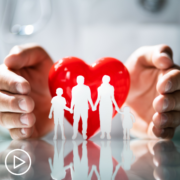Navigating Advanced Endometrial Cancer: Treatment, Prognosis, and Lifestyle Strategies
Navigating Advanced Endometrial Cancer: Treatment, Prognosis, and Lifestyle Strategies from Patient Empowerment Network on Vimeo.
How does the treatment of advanced endometrial cancer prognosis differ from other gynecological cancers? Expert Dr. Charlotte Gamble from MedStar Health shares common challenges that she’s seen with her patients and patient advice to help optimize their care.
[ACT]IVATION TIP
“…I always encourage patients, and when I meet with them for the first time, I ask them, who is your main support person? And if they’re not here right now, let’s actually get them on the phone. They need to be involved from the start to understand this hurdle that you’re going to be going through over the next several months.”
Download Guide | Descargar Guía en Español
See More from [ACT]IVATED Endometrial Cancer
Related Resources:
Transcript:
Lisa Hatfield:
Dr. Gamble, how does advanced endometrial cancer differ from other gynecological cancers in terms of treatment of prognosis, and what lifestyle changes can help improve outcomes for patients with advanced endometrial cancer?
This is such a heavy question, so necessary. I think that, classically what we’re taught is that endometrial cancer is very curable, very treatable.
All you need is a hysterectomy and surgery, and then you’ll be done. But what we see, and specifically in my work, and I take care of mostly Black or African American patients, is that, there are certain types of cancers specifically that are a little bit more prevalent in the, African American community within endometrial cancers that are more aggressive, that need not only surgery, but need chemotherapy and might, because they’re more aggressive, patients come and are already at like stage III or sometimes stage IV, when they’re actually being diagnosed, not due to any sort of delay and recognizing their symptoms or delay in diagnosis, but literally when their symptoms occurred, they were already stage IV. And this is a really, really, really challenging space to be in.
And historically also very challenging because again, as I mentioned, endometrial cancer is one of the least, if not the least funded cancers of the National Cancer Institute in terms of clinical trials. And so there have not been, historically a lot of options for patients who have advanced stage endometrial cancer, aside from our classic chemotherapy drugs with carboplatin (Paraplatin) and paclitaxel (Abraxane) take six cycles. You see how things go and maybe these patients get radiation. And so it’s been a very challenging space to be in over the past couple of years.
As I mentioned, these new immunotherapy drugs are really, giving us a lot of hope and very exciting space, now to see how these novel immunotherapy drugs help to maybe change some of those prognostic factors for patients. But it’s a tougher diagnosis. The survival is not as good as someone who has early stage non-aggressive endometrial cancer.
And so, not only do patients get their surgery, but they’re also getting the chemotherapy. And now, oftentimes getting immunotherapy onto this, and immunotherapy continues after the chemotherapy for oftentimes up to three years. And so patients are on treatment for a lot longer. I think that, you know, in terms of lifestyle changes, again, there’s not a lot of research in this area.
Traditionally, we think of, endometrial cancer as a cancer that is, that can occur more frequently in patients who are overweight, or have elevated BMIs. And so, their cardiovascular health is actually very important. And so lifestyle changes to address their cardiovascular health is going to be much more beneficial than anything else, that occurs. But what I unfortunately see in my practice is that you, might, your heart might be just fine, but if you’ve got cancer that’s in your lungs or in your upper abdomen or in your bones, when you’re diagnosed, that kind of takes over everything, and it’s very difficult to treat.
I think what is important when I personally think about lifestyle factors and, advanced stage of endometrial cancer, is trying to maintain a healthy enough lifestyle and adequate strength to get through the necessary treatments, that are really tough with chemotherapy and immunotherapy. And so the healthier a patient is when they’re diagnosed, the stronger they are through their treatments, the better able that they’re able to maintain their nutrition and as, moderate amount of exercise during their treatments, the better they are able to get through their treatments in a timely fashion.
And a lot of this can be also tied to the amount of support that patients have in their lives. If someone is isolated and has very little, family or friends that are able to be there for them, it’s a much harder mental barrier to get through all of this aggressive treatment than someone who might, have patient or patient advocates with them or friends or family members that are always around.
So I always encourage patients, and when I meet with them for the first time, I ask them, who is your main support person? And if they’re not here right now, let’s actually get them on the phone. They need to be involved from the start to understand this hurdle that you’re going to be going through over the next several months.
So I always tell folks that, you know, I’ll take care of all the medical stuff, I’ll do the surgery, and I’ll run the chemotherapy, and me and my nurse navigator will be able to handle all the medical things. And so you don’t need to worry about that. But the psychological burden this takes, the mental and emotional burden this takes is going to be something that is really going to be much more in the patient’s control and much more in your control as you get through this.
And so finding your support structures and making them, making sure they’re involved from the very start is very, very critical. One of the trials that we have open here, at my health system is looking at the role for increasing social support for patients who are Black, who have advanced stage endometrial cancer and seeing what forms of social support, if that’s group therapy or if that’s one-to-one, peer survivor support or just additional information, if that actually can, which one of those might be the best and help patients get through their therapies. And that’s a trial that’s run by Dr. Doll out of University of Washington.
Advanced endometrial cancer is a tough diagnosis to have, and the survival outcomes, although changing rapidly with the introduction of immunotherapy drugs, are, still a challenge. The lifestyle changes, it really comes to, you know, what patients can do to get through their treatment in a timely fashion. But I think the role of social support and having people that can carry patients through and get them through this tough time is central to this question.
Share Your Feedback:
Addressing Disparities in Gynecologic Oncology | Key Challenges and Solutions
Addressing Disparities in Gynecologic Oncology | Key Challenges and Solutions from Patient Empowerment Network on Vimeo.
What are key challenges and solutions to gynecologic oncology research disparities? Expert Dr. Charlotte Gamble from MedStar Health shares specific factors that show up in research disparities and proactive advice to healthcare providers and researchers to help close the disparity gaps.
[ACT]IVATION TIP
“…for healthcare providers and researchers, is that we have to think about action and what, the evidence-based strategies are to help directly affect the disparate outcomes we see in America for our patients with cancers and to center patients and their concerns within these research questions.”
Download Guide | Descargar Guía en Español
See More from [ACT]IVATED Endometrial Cancer
Related Resources:
Transcript:
Lisa Hatfield:
Dr. Gamble, what are the key challenges regarding the current paradigm of disparities research and gynecologic oncology, and what steps are proposed to overcome these challenges? And what is the role of the patient?
Dr. Charlotte Gamble:
I love this question. This is such a great question because this is like my happy space and where I live, when I’m not taking care of patients directly and kind of where my research interests lie. So to take each question, each question, each part of this question, what are the key challenges regarding the current paradigm of what’s called disparities research? So I think a couple of challenges. One, historically disparities research just meant like looking and seeing what these patient outcomes were and who lived longer and, oh, no, it looks like Black patients are not living as long as white patients, and it looks like poor patients aren’t living as long as rich patients.
And it looks like patients who are living rurally don’t live as long as patients who live in the cities. And so just finding differences and seeing kind of how, again, this critical race practice and how the systems and structures in the United States have contributed or might contribute to these differences that we’re seeing, has classically and historically been easy low hanging fruit.
You look at these large cancer databases, you look at the SEER database, the National Cancer database as well, and can get, pull all these statistics and come up with pretty graphs that just show really wide disparities in Black versus white and versus Hispanic versus non-Hispanic and just say, hey, there are differences and people who are historically marginalized or vulnerable just don’t do as well, which is, okay, fine and good and maybe necessary to have that data to know where we’re starting from. But a challenging in that is that just shows some associations. There is not necessarily causation. There is no attempt to fix the system. It’s merely just stating these are where, this is where we’re at. And at this point, frankly, in 2024 and honestly for the past 15 to 20 years, it’s not anything new. It’s nothing that’s surprising.
Like these have been trends that have been pretty ingrained in this social system and healthcare system that we have in the United States. And so doing kind of disparities that just discusses these differences is a little bit outdated at this point. I think, to answer the second part of that question, what are steps proposed to overcome these challenges? Really moving into, okay, so these differences are there, what are we going to do? So what are these solutions? What are the evidence-based solutions to these differences in how we overcome? So that spans anything from looking at sometimes the molecular tumor makeup that might be different based on ancestry or maybe based on exposure to racism. How does exposure to racism and or stress and over a lifetime influence cancer biology?
If someone has been minoritized and has been exposed to stress because of this for their entire lives, does that change their cancer risk or change the type of cancer they have or change how when they are diagnosed with cancer, how they respond to treatment. None of this has really been very aggressively studied within the gynecologic cancer space. Some of this within the breast cancer space has been looked at, but not very much with the gynecologic cancers.
But then also importantly in this space that I love to live in is, okay, so like, how are we going to overcome the barriers that we discussed earlier? How do we get patients into the healthcare system a little bit earlier when they have abnormal symptoms? How do we get them to a subspecialist if they have transportation barriers, insurance barriers, health system barriers, and how do we actually address what we already know is the problem if they face delays in care, how do we shorten those intervals so they get timely care? And those are harder questions.
It’s harder to publish, it’s harder to get these studies done. They’re really messy. And I think that, there’s a lot of need to actually look at how the system is working or not working for patients and actually doing evidence-based strategies that we know, ie for example, care navigation to help improve the timeliness of care that patients receive.
To answer, and this dovetails well into the third part of the question, which is what is the role of the patient? This is critical because as we start thinking about actually designing interventions to work or to address these barriers, to care, to influence disparities and outcomes, of, patients with these cancers, patients are the center of what we do, and they have to be the center of the research, and they cannot be consulted on the back end after someone has come up with a very pretty project that sounds really nice and like can get funded easily.
They have to be at the center at the start of the project. And so I think it’s really important to center voices of patients in designing research protocols, center them in designing clinical trials, center them in designing community-based outreach programs. This has to, not only come from patients, but feel like it is a patient almost run program. And, I think Kemi Doll really in the gynecologic cancer space, has, been a fierce advocate for, including patients and centering patients and, having patients lead as opposed to follow, as opposed to being adjacent to the project, but being really central to it and to its functioning.
And so when we think about the interventions, when we think about the research questions that are yet unanswered, oftentimes these answers as well as the, logistics of how to get these programs done lies within patients, their communities, their loved ones themselves, and failure to involve them early in the process is a failure of the research project in general. I think my activation to this question is actually for healthcare providers and researchers, is that we have to think about action and what, the evidence-based strategies are to help directly affect the disparate outcomes we see in America for our patients with cancers and to center patients and their concerns within these research questions.
Share Your Feedback:
How Can Gynecologic Oncology Racial Disparities Be Addressed?
How Can Gynecologic Oncology Racial Disparities Be Addressed? from Patient Empowerment Network on Vimeo.
What are some ways that gynecologic oncology racial disparities might be addressed? Expert Dr. Charlotte Gamble from MedStar Health discusses racial inequities in care on different levels and how to start reducing disparities.
[ACT]IVATION TIP
“…understanding how race, racism intertwine with cancer outcomes and access to care, the role that underrepresentation of Black patients on clinical trials has had on the novel therapeutic developments and where these survival gaps worsen when these new drugs are improved or introduced into the system. Because Black patients might not benefit significantly from them, because they have not been represented in the clinical trials as well as they might not have access to these drugs initially when they’re initially rolled out.”
Download Guide | Descargar Guía en Español
See More from [ACT]IVATED Endometrial Cancer
Related Resources:
Transcript:
Lisa Hatfield:
Dr. Gamble, could you elaborate on the racial inequities in cancer outcomes highlighted in your research, particularly with gynecologic oncology? The article or blog mentions the public health critical race practice, so the framework for understanding racial disparity in healthcare. So how can this framework be applied practically in addressing disparities within gynecologic oncology?
Dr. Charlotte Gamble:
Absolutely. I think within gynecologic oncology, again, addressing people who have cancers of the female reproductive tract, ovary, uterine endometrial, specifically within the uterine cancer space, cervical cancer and vulvar cancers. We have multiple levels of racial inequities. When we talk about what cancer outcomes are, these are things like recurrence rates. How quickly does the cancer come back after it’s been treated for the first time? Survival outcomes. So what proportion of patients who have this cancer are living at 5 years? Surgical complications, at 30 days, how many patients had a stroke? How many patients had to be readmitted? How many patients had a blood clot? And so there are definitely different levels of cancer outcomes within the cancer care in general. And what we see within gynecologic cancers is a couple of different things.
So historically within ovarian cancer, there was a thought that there was not too much in terms of survival. Survival outcomes is kind of by far the most commonly cited cancer outcome that is used as a benchmark in all cancer fields. And looking at five-year survival, basically, how what proportion of patients are alive with their cancer at five years. And historically ovarian cancer is, but thought to not have too much of a difference.
When we talk about basically Black, white racial disparities in the United States, although that has been kind of poked at over the past couple years, and there might actually be pretty significant differences when it comes to ovarian cancers and the regionality in part of the country and how long patients live with in general, because ovarian cancer is oftentimes diagnosed at such an advanced stage. Patients do overall, can overall have such significant issues with getting to that five-year overall survival, regardless of race, that again, everything that is influenced by race or the exposure to racism in this country might be washed out just basically because it’s really, really tough when someone has an advanced ovarian cancer diagnosis.
We do know that oftentimes patients who are Black or have been exposed to racism are less often likely to get surgeries, are sometimes more or less likely to get standard of care chemotherapy. And within the ovarian cancer space, over the past 10 years, we really now frequently use genetic testing and the availability of a drug called PARP inhibitor, a targeted oral chemotherapy drug that is used after someone has completed their initial rounds of chemotherapy to help improve their survival. That had really wonderful results about 10 years ago based on several international trials. The challenge though, is when we have novel therapeutics or novel drugs that we give to patients based on really amazing clinical trials, the patients who are most likely to get it are patients who have higher access to care, who might be a little bit more affluent.
And oftentimes this is disproportionately white patients in the United States. And so some of these racial disparities widen for a bit after novel therapeutics are introduced into the system. When it comes to cervical cancer, what we’ve seen historically, is that this is a cancer that is entirely preventable and entirely through a combination of a lot of screening with Pap smears as well as the HPV vaccine. And historically, again, it tends to be disenfranchised, historically marginalized or minoritized patients that might not complete their HPV vaccination series or be able to get the regular Pap smears because their lives end up being pulled in several different directions. And so they end up getting diagnosed with a cervical cancer that is entirely preventable in 2024, as we just saw this young influencer die of an advanced stage cervical cancer. Things like that really shouldn’t happen.
And again, this, the underlying driver of this, we mentioned the critical race practice, is that race or racism is an underlying driver for everything that happens in the United States based on historical issues in this country. And the patients who are disproportionately affected by this tend to be Black minoritized patients. And so that manifests itself in terms of access to Pap smears, access to HPV vaccination screening. In terms of the endometrial cancer space, I love the example that Dr. Kemi Doll uses that really thinking about endometrial cancer is thinking about reproductive health for women and the continuum of thinking about not only the maternal mortality issues that we see for women of reproductive age.
And this extends into postmenopausal women who are disproportionately affected by high risk, aggressive types, advanced stages of endometrial cancer. And so having endometrial cancer as a continuum of reproductive healthcare and involving that in the maternal mortality conversation is a really, I think, helpful way to frame that, that she’s propagated over the past several years.
And so, when we think about endometrial cancers, one of the things that I mentioned earlier is we have these lovely clinical trials that have shown really amazing improvements in overall survival. The kind of nuance to that though is one, these trials weren’t entirely fully representative of the diverse patient population we care for in the United States. There were not enough Black patients in those trials by any means.
Two, the, those new novel immunotherapy drugs work incredibly well in a subset of patients with endometrial cancer, who have what’s called mismatch repair deficient cancers. It’s just a kind of a specific subset of the molecular profile of these endometrial cancers. And these drugs are almost a golden ticket for these patients and really extend survival. And it’s amazing. What is very concerning is that for Black women, the rates of this mismatch repair cancer is not as prevalent.
And so Black women oftentimes have less frequent mutations that will work with these therapeutic drugs. And what I’m very concerned about might happen is that as these drugs are now the golden ticket for a lot of these advanced stage endometrial cancers that specifically have this mutational difference mismatch repair deficiency, Black women might be left behind because the rate of having a mismatched repair deficiency is less for them, and these drugs might not work as well.
And I’m very concerned that we might see a widening in the racial disparities in these cancer outcomes, specifically survivorship for endometrial cancer. As these immunotherapy drugs are increasingly used in clinical practice, even though we use them for all patients, it’s, they work best in a subtype of patients that are oftentimes disproportionately not Black. And I very much worry that we’re going to start seeing a widening in the survival gap as they did for melanoma, when there were novel drugs that address a melanoma treatment pathways that disproportionately did not work well in Black patients.
In terms of activation tip for this question, oh, I think it’s important to take this question in the historical context of this country and understanding how race, racism intertwine with cancer outcomes and access to care, the role that underrepresentation of Black patients on clinical trials has had on the novel therapeutic developments and where these survival gaps worsen when these new drugs are improved or introduced into the system. Because Black patients might not benefit significantly from them, because they have not been represented in the clinical trials as well as they might not have access to these drugs initially when they’re initially rolled out.
Share Your Feedback:
How Is Gynecological Cancer Care Impacted by Social Determinants of Health?
How Is Gynecological Cancer Care Impacted by Social Determinants of Health? from Patient Empowerment Network on Vimeo.
How can social determinants of health impact gynecological cancer care? Expert Dr. Charlotte Gamble from MedStar Health explains common factors that can present barriers to care and some resulting impacts to patient care.
Download Guide | Descargar Guía en Español
See More from [ACT]IVATED Endometrial Cancer
Related Resources:
Transcript:
Lisa Hatfield:
Dr. Gamble, how do social determinants of health potentially influence the quality of care received by patients with gynecologic cancers?
Dr. Charlotte Gamble:
Yeah, another really wonderful question and an area of research that people have looked at for a long time. I think when we think about social determinants of health, we have to define what they are, right? So these are going to be aspects of people’s lives that might not be specifically health related, but absolutely influence the ability to access healthcare, the ability to complete treatment regimens, the ability to be able to get support and survive these treatment regimens and continue in survivorship.
So think when we, when I specifically think about social determinants of health and gynecologic cancers and encompassing the ovarian cancers, cervical cancers, endometrial cancers and vulvar cancers. We see multiple things. So in general, these cancers are affecting people who have the female reproductive tract. So this is going to be oftentimes people that identify as women, but also can include trans men.
And so there’s also like a gender component of this and how people identify. And for the trans community, there are barriers everywhere in terms of how they can access gynecologic care and the stigma that might be associated with providing trans healthcare in general that affect them specifically. When we talk about women or people who have identified as women and who also have a female reproductive tract, there comes into place how women in general and historically have been able to access healthcare and the barriers that they might face in communities.
Women generally tend to be the providers of healthcare or the providers of childcare and have several responsibilities in taking care of their families and communities. And in so far, doing tend to downplay their own healthcare and prioritizing their own well-being to be able to care for those who they love, who surround them and are stretched thin.
And so because of that, we oftentimes see delays in seeking access to healthcare because women tend to be pulled in so many different directions by their communities. Other times what we see is things that I’ve mentioned previously in terms of insurance barriers and either not having insurance. So for patients who are undocumented immigrants, this tends to be a massive issue. I’ve had patients myself that we’ve had to work tirelessly for, to be able to get them insurance. And this is in the nation’s capital where insurance, even for undocumented people, tends to be a little bit easier to access than in other places. And it’s been a huge challenge and delay their care by months. And this directly correlates with survival and how patients do on the back end of things. But even having insurance that is, that is, doesn’t, might not cover everything that’s needed, and there might be large copays associated with visits or treatment plans.
This is an area that there’s a lot of room to improve in the United States, and a real macro issue. But when it comes to also things like transportation and living in a food desert and not having healthy groceries and nutritional options that for patients who have endometrial cancer, that oftentimes if it’s a low grade non-aggressive cancer, they’re going to do fine from a cancer standpoint, but it’s the cardiovascular issues and the possible severe obesity they might suffer from. And that is an issue that patients who live in food deserts or live in places that they can’t access sidewalks and ability to live healthy lives in their neighborhood will really suffer from not being able to have those determinants of health work in their favor.
And then we also have issues within health systems. And we see that for patients who live in conditions that are historically considered impoverished, they might not be able to make it to the beautiful National Cancer Institute designated cancer center, seeing this most subspecialist and having access to five clinical trials and a case navigator and a care navigator and a social worker to help them through the social issues that they might be seeking care with a community practice that could itself be underfunded or not linked to strong cancer institute options.
And so that’s another kind of systems level that we see where patients are seeking care that they might not be able to actually get to the subspecialists that they need, or health systems that are resourced enough to help them in their lives. So that’s a very long-winded question, [laughter] because it’s such a massive issue. But it, social determinants of health affect everything in the cancer continuum from a timely diagnosis and being able to recognize abnormal symptoms to being able to get into a doctor’s office, to be able to get to a subspecialist that is has expertise in the area to be able to complete therapies on time and to be able to eat healthy food and have a healthy lifestyle after one has gone through all these major treatments. It’s a massive issue and something that we see in every single health condition in the United States.
That is the most excellent comprehensive response to barriers, obstacles, stigmas that I’ve ever heard regarding accessing quality of care for cancer patients. Any cancer patient is going to benefit from your response to that. So thank you.
Share Your Feedback:
Are Beauty Products a Risk Factor for Endometrial Cancer?
Are Beauty Products a Risk Factor for Endometrial Cancer? from Patient Empowerment Network on Vimeo.
Do some beauty products pose a risk factor for endometrial cancer? Expert Dr. Charlotte Gamble from MedStar Health discusses studies that investigated endometrial cancer risk and beauty products that may be a risk factor.
[ACT]IVATION TIP
“If patients have a concern about hair straightener products in general, then maybe it’s time to start avoiding them. But if it’s something that is really important to you and is a crux of who you are as a human being, then I’m not sure we have enough data to say you should absolutely avoid this, and this is contributing to your cancer risk.”
Download Guide | Descargar Guía en Español
See More from [ACT]IVATED Endometrial Cancer
Related Resources:

|

Advancements in Endometrial Cancer Trials | Insights and Opportunities |

|
Transcript:
Lisa Hatfield:
Dr. Gamble, there are often questions around the use of hair products and gynecological cancers. Can you speak to this and whether there are any correlations or risk factors with the use of these hair products?
Dr. Charlotte Gamble:
Absolutely. This is also an area of some controversy, and the data has yet to really be accepted or validated. And it’s, I think, an area that needs so much additional research. So, you know, within the past few years, there have been a few major studies that have looked at patients, looking back at patients who have then developed endometrial cancer and seeing what kind of risk factors they might have had compared to patients who didn’t develop endometrial cancers. And looking at the types of patients within these studies, there are some subtle differences that need to be addressed.
The overall conclusion from these studies was that the frequent use of hair straightener products might increase the risk or is associated, I should say, with a risk of developing uterine or endometrial cancer. But the nuances within how these studies were conducted and which populations they were done in, I think deserves a little bit of detail and insight.
One of the major studies was done in a cohort group of patients who had actually close family members who had breast cancer. And so this is actually a very specific type of patient population where they were already at somewhat of an increased risk of developing a type of a cancer, because they had a relative that had breast cancer. And in this cohort of patients, they found that the frequent use of hair straightener products was associated with a higher likelihood of developing uterine cancer.
The kind of challenges I have with this is not only the patient population looking at it being predominantly groups of folks who already have a relative with a cancer, but then also the cohort itself is predominantly Caucasian or white, with 85 percent being white and a very small percentage of those patients being Black. And it’s hard to actually draw conclusions based on that, again, with just not a great representation of Black women who can be frequent users of hair straightener products.
And then there are nuances of like, what is a hair straightener product? What does that mean? Is that a chemical relaxer? Is that a Brazilian? And how does that actually affect the endometrial cancer risk? And we don’t know. Again, it’s a correlation, an association, but not a causation. The other study was done in a cohort of patients who were Black in the Black Women’s Health Study. And so it was a much better representation of patients that I take care of and are at risk of endometrial cancer. And the challenge with this study was that there are several different nuances and kind of when the cancer occurred and if it was pre-menopausal, before menopause or after menopause and the type of cancers they were. And I think a lot of this data is pretty compelling that there’s probably some degree of an association.
But it’s very difficult to know how that actually relates to the type of cancers that we see most frequently in Black women, which are aggressive, non-hormonally responsive cancers that might not have any sort of risk that’s tied to hair straightener products that generally do a hormonal cascade. So my activation tip for this question is we do not know. The jury is out. There are some initial studies that look at this association and for patients and how they take care of their hair. If patients have a concern about hair straightener products in general, then maybe it’s time to start avoiding them. But if it’s something that is really important to you and is a crux of who you are as a human being, then I’m not sure we have enough data to say you should absolutely avoid this, and this is contributing to your cancer risk.
Share Your Feedback:
Should Some Gynecologic Cancer Patients Seek a Specialist?
Should Some Gynecologic Cancer Patients Seek a Specialist? from Patient Empowerment Network on Vimeo.
Why might some gynecologic cancer patients want to see a specialist? Expert Dr. Charlotte Gamble from MedStar Health explains the reasoning of seeing a specialist and why a specialist may not be seen in some areas.
Download Guide | Descargar Guía en Español
See More from [ACT]IVATED Endometrial Cancer
Related Resources:

|

Advancements in Endometrial Cancer Trials | Insights and Opportunities |

|
Transcript:
Lisa Hatfield:
A lot of people in our audience are going to community facilities for their care. Do you recommend for patients who are diagnosed with any type of gynecologic cancer to seek out a specialist or a subspecialist to get more information or do you feel confident that they can ask these questions if they’re a local oncologist, if they do not specialize, if they’re more of a general oncologist versus a specialist?
Dr. Charlotte Gamble:
This is such a nuanced question and is probably a little bit controversial within the oncology sphere. So endometrial cancer is a gynecologic cancer. And because of that, historically, the providers that have the most specific expertise in that area have traditionally been gynecologic oncologists. These are both surgeons as well as oncologists that do the surgery as well as the chemotherapy or the targeted therapy. We are now in a space where sometimes that care is a little bit fractioned, and there’s different ways of practicing within this realm of gynecologic oncology throughout the country.
And so some health systems have gynecologic oncologists, more of the surgeons that work very closely in partnership with medical oncologists that might treat specifically gynecologic cancers, or sometimes are more general medical oncologists that treat multiple different kinds of cancers. I would say that, and then there are some places where gynecologic oncologists do it all.
So I actually work in a hybrid system where I, in one hospital that I work at, I’m the gynecologic oncologist and do both the surgeries as well as the chemotherapy. And then at a community site that I work with, I do the surgeries and I work closely with general medical oncologists who are able to provide the chemotherapy or the targeted therapies.
I would say that for patients who are receiving care within a general medical oncology practice, a very good question to ask their medical oncologist would be, are you in contact or how closely do you work with gynecologic oncologists in terms of taking care of patients with gynecologic cancers? Because traditionally, medical oncologists might not receive the depth of education in gynecologic cancers that gynecological oncologists actually need to go through and that patients deserve. And I have worked with several medical oncologists who are absolutely wonderful, but it is a close partnership that we are making these plans together and they understand the gynecological oncology literature and I’m able to guide those therapies for my patients.
Lisa Hatfield:
That’s great clarification for patients who might be facing this disease and a great question they can pose to their local oncologist. So thank you for that.
Share Your Feedback:
Advancements in Endometrial Cancer Trials | Insights and Opportunities
Advancements in Endometrial Cancer Trials: Insights and Opportunities from Patient Empowerment Network on Vimeo.
What’s important for endometrial cancer patients to know about clinical trials? Expert Dr. Charlotte Gamble from MedStar Health discusses novel therapies under study, treatments that are showing promising results, and patient advice on clinical trials.
[ACT]IVATION TIP
“…be able to ask your doctor about if you’re eligible for clinical trials, what your cancer mutational or genetic code is that might make you eligible for certain clinical trials, and where those trials are offered, if it’s at the health system that you are seeking care, or if it’s at a nearby health system, if you’re able and willing to travel.”
Download Guide | Descargar Guía en Español
See More from [ACT]IVATED Endometrial Cancer
Related Resources:

|

|

|
Transcript:
Lisa Hatfield:
So, Dr. Gamble, this is kind of a three-part question about clinical trials. Can you talk a little bit about ongoing clinical trials that are investigating novel therapies for advanced endometrial cancer? And then maybe talk a little bit about some promising or encouraging results that you’re seeing with trials? And last part of the question is, what do you want people living with endometrial cancer to know about clinical trials?
Dr. Charlotte Gamble
I’m so glad you asked this question. This is such a valuable question and an area of a lot of interest that has improved over the past several years, not only about clinical trials and the real need to make sure that patients are aware of them and to ensure that these clinical trials represent the populations that we intend to serve as healthcare providers in the United States, but also specifically in the world of endometrial cancer. Really exciting, promising results that we’ve had over the past year, year-and-a-half specifically that address the very desperate need for novel therapeutics to treat patients who have endometrial cancer.
So, for example, two major trials were published last year, presented at international meetings, looking at the real improvement in overall survival, really increasing the length of time patients can live with endometrial cancer that leverage the use of drugs called immunotherapy. So things like dostarlimab-gxly (Jemperli) or pembrolizumab (Keytruda), these are generic names for immunotherapy drugs that work very well in some subsets of patients with endometrial cancer.
This is something, some survival benefits that we have never seen before in the endometrial cancer space and rarely seen in the gynecologic oncology space and is a definite marker of huge success in terms of extending the lifespan of patients who suffer from this challenging to treat understudied, underfunded disease. Endometrial cancer is actually one of the lowest funded studies in the National Cancer Institute at NIH.
And so having major trials come out over the past couple of years that really look at survival opportunities with the leveraged use of immunotherapies is something that is both exciting and invigorating to the field and hopefully can potentiate further funding from the NCI to be able to study this disease type. In terms of your question for what patients should know about, about ongoing trials, I think this dovetails into several of the points that we’ll discuss during this interview of making sure that patients are their own advocate and having an advocate nearby and with them at all of their appointments.
So it’s really important to ask their subspecialists, their oncologists or their gynecologic oncologists about if there are any clinical trials that the patients are eligible for. A lot of this comes down to, has the patient undergone genetic testing or molecular sequencing that looks at the specific mutations in the cancer tissue that sometimes will make patients eligible for certain clinical trials or others? And other times it’s just understanding that what opportunities are available within the health system and outside the healthcare system in which the patient is seeking care.
A lot of times when we see that these trials that are published might not represent a racially diverse group of patients. Oftentimes it’s because of two reasons. One, patients aren’t even offered clinical trials, even if they are eligible. Or two, patients might be getting care at a health facility that doesn’t have access or the infrastructure to enroll them on these clinical trials that could be available, perhaps at a regionally nearby cancer center.
I oftentimes suggest to patients, please ask me questions about your molecular subtyping. Ask me questions about what clinical trials you might be available for. There is a significant amount of trust that the health system needs to earn back from patients to allow them the headspace to trust the health system again, given historical, massive, ethical issues and trials in the past and patients and their loved ones feeling that clinical trials just means a big experiment and they don’t want to be experimented on. And what I often say to that is really, you have to understand the details of the trial and the science going into it and make sure that your doctor has your best interests at heart. But oftentimes these trials hold significant promise.
And the reason that you might be eligible for them is that the trial drugs might work better than standard of care, certainly for endometrial cancer we’ve seen that in the two major trials that came out this year. So I think my activation tip for this question is really to be able to ask your doctor about if you’re eligible for clinical trials, what your cancer mutational or genetic code is that might make you eligible for certain clinical trials, and where those trials are offered, if it’s at the health system that you are seeking care, or if it’s at a nearby health system, if you’re able and willing to travel.
Share Your Feedback:
What Are Barriers to Endometrial Cancer Care Access?
What Are Barriers to Endometrial Cancer Care Access? from Patient Empowerment Network on Vimeo.
How can endometrial cancer care access be obstructed by barriers? Expert Dr. Charlotte Gamble from MedStar Health discusses common barriers to care and patient advice to overcome some barriers.
[ACT]IVATION TIP
“…rely on the support that you have in your own lives to make sure that all the barriers that are in your control you can properly address and sometimes that takes a village and to really make sure that you have an advocate either a family friend, or a family member who could help get you and navigate you through this cumbersome process.”
Download Guide | Descargar Guía en Español
See More from [ACT]IVATED Endometrial Cancer
Related Resources:

Advancements in Endometrial Cancer Trials | Insights and Opportunities |

|

|
Transcript:
Lisa Hatfield:
Dr. Gamble, can you speak to barriers to accessing care in endometrial cancer?
Dr. Charlotte Gamble:
Absolutely. What I’ve seen from some of my research, both with myself as well as with Kemi Doll, when we talk to patients and speak to them about what are the issues they face into getting timely gynecologic oncology care, it’s a myriad of factors. So there are some barriers at different levels. So patients themselves face barriers in their own lives where they might not understand the symptoms of endometrial cancer, which oftentimes are a postmenopausal bleeding, or sometimes bloating, or pelvic fullness, and sometimes are really busy doing other things in their lives that they can’t prioritize their own health and kind of ignore some of the symptoms.
And so knowledge gaps are a barrier. And the logistics sometimes of making it to a doctor’s office or their provider’s office can oftentimes be challenges that patients might face in their own lives. However, a lot of my concern also comes to the provider level barriers where sometimes when patients are legitimately concerned, rightfully so, with symptoms they might be having, oftentimes the health system might ignore their symptoms.
And so they might run into barriers when they actually try to call and schedule an appointment with their gynecologist or with their primary care doctor discussing symptoms, and they might be told that this doctor doesn’t have availability for the next three to four months, come and see us in August, which presents a whole set of delays that the patients face. And this might be somebody that’s an administrator for the office, the front desk staff that just might not have the insight to be able to escalate that concern upwards.
Additionally, what we see is that sometimes when patients come to their providers with these concerns, the providers themselves might not have the knowledge area or the level of concern to meet that need that patients have. And so sometimes can misdiagnose patients or not get a timely workup in place. And that’s something that the health community I think, needs to work on as well. And lastly, the health system is messy. We have a messy health system in the United States and lots of fragmentation and care.
And so the process, even when somebody appropriately raises a concern to their primary provider, gets the appropriate workup, gets a diagnosis, sometimes it’s actually very difficult for them to get that referral and make it to the oncologist or the subspecialist’s office in a timely fashion. And some of that, you know, some of my research right now goes into how can the health system be better about coordinating and helping patients navigate what is a very burdensome and cumbersome health system. So barriers are at several levels. They’re at the patient level, they’re at the organizational level, they’re at the health system level. Ranging all the way from, I didn’t know that this could be a problem, this symptom I’m experiencing, to, I don’t have the correct type of health insurance to be able to cover the subspecialty care that I now need.
Share Your Feedback:
Overcoming Barriers: Empowering Underrepresented Groups With Endometrial Cancer
Overcoming Barriers: Empowering Underrepresented Groups with Endometrial Cancer from Patient Empowerment Network on Vimeo.
How can endometrial cancer care barriers be overcome for underrepresented groups? Expert Dr. Emily Hinchcliff from Northwestern Medicine discusses racial and cultural barriers and advice to patients to be proactive toward receiving optimal care.
[ACT]IVATION TIP
“…know the genetic status of your tumor, specifically something called the mismatch repair status of your tumor. And then not only how does that status impact your own treatment, but also how that may impact your family members…understand what resources are out there for you as a patient, especially for women in underserved groups and minority populations.”
Download Guide | Descargar Guía en Español
See More from [ACT]IVATED Endometrial Cancer
Related Resources:

|

Innovative Approaches to Endometrial Cancer Care in Underrepresented Communities |

Endometrial Cancer Care Disparities: The Impact of Rural Residence |
Transcript:
Lisa:
Dr. Hinchcliff, in your research, you dive deeply into the significant disparities that exist within medically underserved and minority populations in the U.S. when it comes to awareness of, access to, and the use of genetic services in endometrial cancer. Can you speak to the research and provide tips to these patients and families?
Dr. Emily Hinchcliff:
Yeah, so I think that there are sort of two different pieces that go on here. First is the relationship of endometrial cancer, that some of it can be, I guess, at random, and some of it can be genetic. So understanding, especially for those who have a strong family history, that there are hereditary forms of endometrial cancer. I think that’s a really important point for patients to take away. And then we, as a society, as a field, now recommend kind of routine screening for those tests to determine, Is an endometrial cancer hereditary or not? So make sure that you, as a patient, know your results and know if your family members should be tested in any way.
The second is regarding the significant disparities that exist. We know, as a field, as a kind of medical subspecialty, that there is a racial disparity in endometrial cancer mortality. While there is a lot of research going on to address the kind of potential biologic component there, is there something different about the cancers that are developed in different racial groups? I think there’s also really important research going on about the kind of systemic and cultural barriers and differences that women of different races experience that also can dramatically impact their cancer care.
Lisa:
And do you have an activation tip for this question?
Dr. Emily Hinchcliff:
I’ll give you two different activation tips. I think that the first is to know the genetic status of your tumor, specifically something called the mismatch repair status of your tumor. And then not only how does that status impact your own treatment, but also how that may impact your family members. And then I think the second is to understand what resources are out there for you as a patient, especially for women in underserved groups and minority populations. Simply obtaining support can often be a really important key first step to gaining access and understanding of your disease.
Share Your Feedback
Innovative Approaches to Endometrial Cancer Care in Underrepresented Communities
Innovative Approaches to Endometrial Cancer Care in Underrepresented Communities from Patient Empowerment Network on Vimeo.
How can endometrial cancer care use innovative approaches in underrepresented communities? Expert Dr. Emily Hinchcliff from Northwestern Medicine discusses diagnostic testing tools and support in navigating clinical trials.
[ACT]IVATION TIP
“… doing your own research and your own reading is really important, being your own advocate. But I think that your physician can serve as an excellent, almost medical translator to understand what is right for you and which of the many, many novel things that we are discovering every day is applicable to you and which might be good for you and which don’t actually apply or which are not potentially your best option in that side.”
Download Guide | Descargar Guía en Español
See More from [ACT]IVATED Endometrial Cancer
Related Resources:

|

Overcoming Barriers: Empowering Underrepresented Groups With Endometrial Cancer |

Endometrial Cancer Care Disparities: The Impact of Rural Residence |
Transcript:
Lisa:
Dr. Hinchcliff, are there any innovative approaches or technologies that you and your team are exploring to improve endometrial detection, treatment, or support services, especially for your underrepresented communities with limited access to healthcare resources?
Dr. Emily Hinchcliff:
Yeah, so there are many, many different things that we’re doing here that we’re very excited about. I think I’ll probably highlight two. So one of the ones that I have been working on closely is there is an ever-increasing number of diagnostic testing tools that we have within our kind of armamentarium. And so one particular test that patients may have read about or heard about is something called circulating tumor DNA. And this is a pretty novel test that I will be completely open and honest that we don’t totally know how to use or how to incorporate in our cancer surveillance, meaning so once someone is diagnosed, is this a test that can help us to watch to see if treatments are working or watch to see if a cancer may have come back? Similarly, can it be used as a screening tool? We just don’t know that, and so that’s an area that I am actively working in.
The other thing that one of my colleagues here is working on is trying to really create access for women who have limited access to healthcare. So we have developed a clinical trial platform to allow the women, specifically of Chicago, to better understand their options for clinical trials across the institutions in Chicago. So we have at Northwestern multiple cutting-edge endometrial cancer trials trying to bring these novel therapeutics to the forefront and to patients and also to thoughtfully triage patients to kind of treatments that we think are going to maximize their effectiveness and minimize toxicity.
But similar to us, the other institutions around Chicago have a different panel of clinical trials. And so for patients, it can be really overwhelming to know which trial, which institution, how do I know, how do I access all of that? And so we’re working to create a platform for patients and to have clinical navigators associated to help them to understand their options.
Lisa:
And do you have an activation tip?
Dr. Emily Hinchcliff:
So I think that when patients are thinking about innovation and how can they make sure that they are at the cutting edge, I think that your physician is really your access point. So obviously, doing your own research and your own reading is really important, being your own advocate. But I think that your physician can serve as an excellent, almost medical translator to understand what is right for you and which of the many, many novel things that we are discovering every day is applicable to you and which might be good for you and which don’t actually apply or which are not potentially your best option in that side.
Share Your Feedback
Overcoming Geographical Barriers in Endometrial Cancer Care
Overcoming Geographical Barriers in Endometrial Cancer Care from Patient Empowerment Network on Vimeo.
How can endometrial cancer care barriers be overcome in regards to geographic location? Expert Dr. Emily Hinchcliff from Northwestern Medicine discusses geographic care barriers, solutions, and patient advice to be proactive in their care.
[ACT]IVATION TIP
“…understanding that post-menopausal bleeding is never normal and that you need to see a physician for that…regarding the fact that accessing care can be, as you mentioned, done in many, many different ways these days. And so understanding what your options are, whether that’s telehealth, whether that’s a consult visit and then receiving the majority of the subsequent care closer to home, you have a lot of options.”
Download Guide | Descargar Guía en Español
See More from [ACT]IVATED Endometrial Cancer
Related Resources:
Transcript:
Lisa:
If a woman goes in and is diagnosed at her local cancer center and has endometrial cancer, should she see some type of subspecialist, would it be of benefit to that patient maybe to even do a consult, a telemedicine consult at least upon diagnosis? Or how can a person who is more remote geographically access a subspecialist care or expertise?
Dr. Emily Hinchcliff:
Yeah, absolutely. So I think that telehealth has really changed medicine in general and provides some really great opportunities for access. There is a big kind of dichotomy in endometrial cancer where early stage disease is often caught because it has a symptom, vaginal bleeding is a symptom. And so early stage disease can often be treated with surgery alone.
And so that surgical management, again, can potentially be done by a GYN oncologist at a one single time point. The subsequent care, so I’ll just use myself as an example. I will often see women for sort of that initial visit, treatment decision, sometimes surgery, but then if they need additional adjuvant therapy, such as chemotherapy, they’ll go closer to home to receive some of those therapies. And then I will serve as a bit of a consultant to their providers closer to home to discuss what treatment options, what regimens and how to manage toxicities might be good in their case.
Lisa:
And do you have an activation tip for patients for that question?
Dr. Emily Hinchcliff:
Yeah, so I think that my activation tip here regarding barriers to endometrial cancer care is first and foremost addressing the knowledge gap, understanding that post-menopausal bleeding is never normal and that you need to see a physician for that, I think is the first key tip. The second tip, I guess, if I could give a second activation tip, is regarding the fact that accessing care can be, as you mentioned, done in many, many different ways these days. And so understanding what your options are, whether that’s telehealth, whether that’s a consult visit and then receiving the majority of the subsequent care closer to home, you have a lot of options. And we as a field in GYN oncology are really collaborative. And I think most of us would feel very positively towards creating a team to help you get the care you need.









